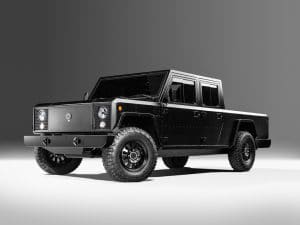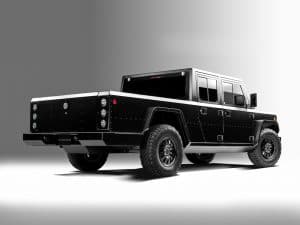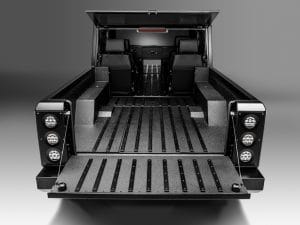You could be excused if the flood of new battery-electric vehicles – and brands – is starting to get you confused. But expect to see the trend continue, Bollinger being the latest to roll out what it’s billing as two new models set for production, the B1 SUV and B2 pickup.
The start-up has been teasing its plans and showing off concepts for some time. In the meantime, things have been amping up rather aggressively, with all sorts of new entries into the electric SUV and truck segments – even GM and Ford confirming plans for battery pickups of their own. If anything, Bollinger is most likely to be compared to Rivian, the suburban Detroit start-up that revealed its R1S and R1T models at the Los Angeles Auto Show last November.
If anything, Robert Bollinger’s new entries adopt an even more commercial, even military-style appearance. And the industrial-designer-cum-gentleman-farmer contends they are designed to handle serious work, not just making owners look cool and environmentally hip. These are the first electric models expected to get Class 3, heavy-duty ratings. Think Ford F350 Super Duty.
(Bollinger Takes Wraps off New B2 Pickup Truck)
That translates into a payload of 5,000 pounds and towing capacity of 7,500 pounds, and topping 10,000 pounds gross weight. While the towing numbers are light compared to some of the conventional, gas-powered pickups now on the market, the overall capabilities claimed by Bollinger are still impressive.
Bollinger, who made his fortune in, of all places, the cosmetics industry, would seem an unlikely automotive magnate, but he came up with the idea for what became the B1 and B2 while working a farm he’d purchased in the Catskill Mountains, a few hours north of New York City.
“I wanted to go back to a childhood dream of starting something automotive,” he explained during a Detroit unveiling on Thursday night. “I needed a truck out of necessity, it’s what I wanted to drive.”
Visually, the SUV and pickup are all but identical, with a squared-off appearance that will remind some of the Hummer H1, perhaps, or the original Land Rover Defender. There are very few frills, but some interesting quirks, such as the triple windshield wipers and a roof that can be opened up to the elements by removing four panels – available in either glass or aluminum.
The battery pack isn’t quite as large as what Rivian is promising but, at 120 kilowatt-hours, still enough to deliver about 200 miles of driving when loaded up. It is also expected to deliver about 10 hours operating time off-road. And while not quite a Tesla running in Ludicrous Mode, Bollinger claims the trucks will manage to hit 60 mph in 4.5 seconds thanks to twin motors – one on each axle – each pumping out 307 horsepower and 334 pound-feet of torque. The B1 and B2 will be among the rare electrics to use a two-speed gearbox, here better enabling off-road operations.
(Bollinger Eyeing Downtown Detroit for Truck EV)
There are a variety of other intriguing features, not all of them unique. Like the old Chevrolet Avalanche, the B2 pickup will have a “midgate” allowing extra-long cargo by opening up pass-through space to the back seat. That approach effectively adds an extra 24 inches to the six-foot bed.
The trucks offer variable ground clearance of up to 20 inches, Land Rover territory. And they feature a cross-linked hydropneumatic suspension that enhances stability, but also can be decoupled for enhanced off-road flexibility. There also are the requisite knobby tires and dual locking differentials. And, for long objects, there’s a cross-vehicle pass-through space, a concept also adopted by Rivian.
Working a farm or some other dirty application and the interior can be hosed out, as can the “frunk” under the hood.
By falling into Class 3, Bollinger can skip airbags, but there are antilock brakes and electronic stability control is under development.
An early prototype of the B1 was introduced in Manhattan in 2017 and, since then, Bollinger claims it has had nearly 30,000 “hand-raisers.” How many will actually plunk down cash remains to be seen – as will be the final pricing.
(“Consumers Do Not Want to Buy or Drive” EVs? That’s Not the Story in Europe)
Bollinger plans to get the two new trucks into production in late 2020 at a factory in the Detroit suburb of Ferndale. Despite their Spartan level of accessories, pricing is likely to fall into Ranger Rover territory.




This is what you get when the designer’s only tool is a straight edge.